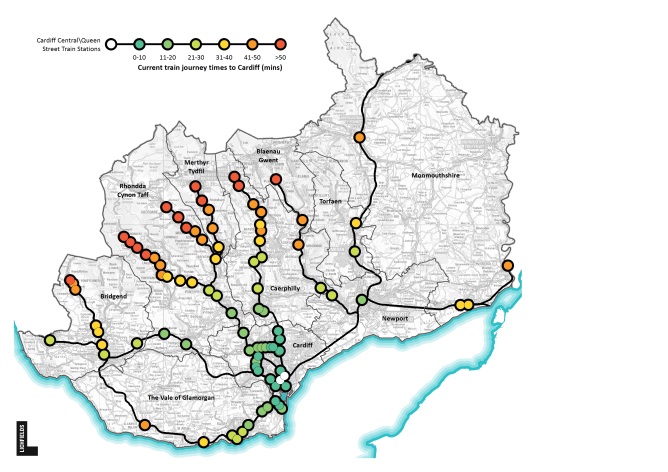This blog forms the second in a series on the implications of the Cardiff Capital Region City Deal on planning for housing in South East Wales. It expands upon some of the issues considered in our Insight Focus, Cardiff Capital Region: Planning for Growth.
The Cardiff Capital Region (CCR) City Deal aims to increase skills and improve employment opportunities, against a backdrop of a recognised skills shortage across the region
[1]. The City Deal Regional Cabinet has already agreed to invest £37.9 million in the development of a compound semiconductor industry cluster in Newport, which is expected to create 2,000 highly-skilled jobs. Hence, there is a need to support the development of a better-skilled workforce in order to anchor the benefits of new job opportunities within the region and help ensure the City Deal momentum continues.
Alongside direct efforts to upskill the local workforce, there is a need to think more broadly about how to address the issue of retention of local residents as they progress through their careers and of attracting people with the right skills from elsewhere. This wider strategy should include a focus on housing – not only providing the required number of homes but also the right type of homes and in the right locations in order to strengthen the region’s offer to the ambitious and highly skilled.
For younger workers and recent graduates, there is a need to provide good quality private rented homes and smaller homes for purchase. This could help to address the issue of low graduate retention, which was recognised by the CCR’s Growth and Competitiveness Commission (2016)
[2] as a particular problem for the region, despite its internationally competitive higher education institutions and further education colleges. For more experienced professionals, it is important to provide larger “aspirational” homes in family-friendly neighbourhoods. This will be necessary in order to reduce the likelihood that upwardly mobile residents will leave the area at the point when they can afford a better home or are looking for a suitable community in which to raise children, and to support the inward migration of such new workers.
According to research conducted by Centre for Cities
[3], proximity to the workplace is one of the main considerations in choosing where to live for young people in particular. Jobs in high tech industries tend to be clustered around specific locations (the compound semiconductor industry cluster, for example), in contrast to the service industries, where employment is more dispersed. The Growth and Competitiveness Commission Report recommends that the CCR complement its economic strategy by way of a spatial development perspective which recognises the roles of different locations, including Cardiff and Newport as established commercial hubs, Cardiff Airport with its associated Enterprise Zones, and towns such as Bridgend, Barry, Caerphilly and Pontypridd that are “in transition to accommodating high value added activity”. Whilst it is not always possible to build new homes in close proximity to high tech sectors, there is an opportunity to consider how to link new housing to these high tech industry locations by sustainable travel modes.
The South Wales Metro project offers a powerful opportunity to open up access to key employment hubs. In addition to increasing the frequency of existing rail services, the Metro project is intended to provide new services, routes and stations and has the potential to decrease travel times on existing routes by more than 20% (see figure 1 and 2), according to Welsh Government’s South Wales Metro brochure (2015).
Figure 1 Current train journey times to Cardiff
Source: Lichfields analysis of National Rail data and Welsh Government “Rolling Out Our Metro” brochure
Figure 2 Potential future train journey times to Cardiff following the completion of the South Wales Metro
Source: Lichfields analysis of National Rail data and Welsh Government “Rolling Out Our Metro” brochure
The completion of the South Wales Metro would bring all of the existing stations in the CCR within a 50-minute train journey time of Cardiff, compared to a current maximum journey time of an hour. Following the completion of the Metro, a train journey of 30 minutes from Cardiff could take you as far as Caldicot to the east, Bargoed and Abercynon to the north and Sarn to the west. Journeys to the other key employment hubs in the CCR would also be significantly improved.
By comparison, in 2015 the average door-to-door commute for UK workers was 28.5 minutes (one-way), while the average journey for those travelling by train was substantially longer, at 65.2 minutes
[4]. The proposed reductions in journey times within the CCR would therefore bring a vast area of the region within reasonable commuting distances of key employment areas.
However, it cannot be assumed that buyer demand for homes will immediately increase in the areas furthest away from the key employment centres in the CCR. Even after demand begins to increase, it will take time for land values to rise sufficiently to provide developers (and, more importantly, their funders) with the confidence to invest in areas that are currently less attractive. When planning for housing across the region, it is therefore important to be realistic about the areas that will be viable for development. New planning policy, whether it takes the form of Local Development Plans or a Strategic Development Plan for the region, should take account of the need to support housing growth and not to stifle development opportunities that could help to kick-start the transformation of the region.
Over time, it is hoped that the continued growth of the parts of the CCR that are already vibrant will spread to every community. New housing can provide a catalyst for this growth by bringing new residents, attracting additional spending in local businesses and enabling new businesses to be set up. However, in order to be successful, there must be an appropriate mix of housing in locations that match the needs and aspirations of skilled workers in particular.
[1] Learning, Skills and Innovation Partnership South East Wales Employment and Skills Plan (2016)
[2] Growth and Competitiveness Commission Report (November 2016)
[3] Centre for Cities (November 2015), “Urban Demographics – why people live where they do”
[4] 2015 ONS Labour Force Survey data published by the Trades Union Congress.





